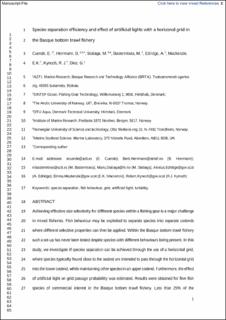Species separation efficiency and effect of artificial lights with a horizonal grid in the Basque bottom trawl fishery
Cuende, E.; Herrmann, Bent; Sistiaga, Manu; Basterretxea, M.; Edridge, A.; Mackenzie, E.K.; Kynoch, R.J.; Diez, G.
Peer reviewed, Journal article
Accepted version
Permanent lenke
https://hdl.handle.net/11250/3056184Utgivelsesdato
2022Metadata
Vis full innførselSamlinger
- Institutt for marin teknikk [3421]
- Publikasjoner fra CRIStin - NTNU [37737]
Sammendrag
Achieving effective size selectivity for different species within a fishing gear is a major challenge in mixed fisheries. Fish behaviour may be exploited to separate species into separate codends where different selective properties can then be applied. Within the Basque bottom trawl fishery such a set-up has never been tested despite species with different behaviours being present. In this study, we investigate if species separation can be achieved through the use of a horizontal grid, where species typically found close to the seabed are intended to pass through the horizontal grid into the lower codend, while maintaining other species in an upper codend. Furthermore, the effect of artificial light on grid passage probability was estimated. Results were obtained for five fish species of commercial interest in the Basque bottom trawl fishery. Less than 25% of the individuals of all species analysed passed through the grid and were retained in the lower codend, and no significant differences were found when the grid was illuminated. The specific conditions under which the Basque bottom trawl fishery is conducted, i.e., high turbidity levels, high towing speed, may have influenced the performance of the gear in this fishery. Consequently, the design was found to have limited potential to improve species and size selection in the Basque bottom trawl fishery.
